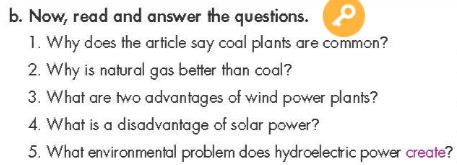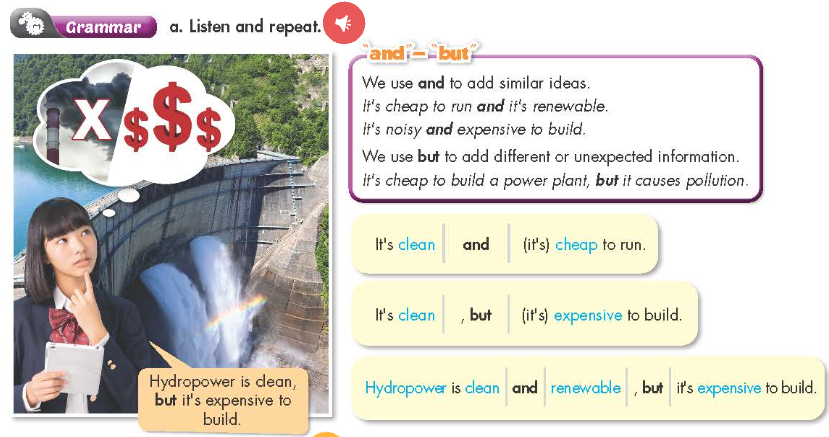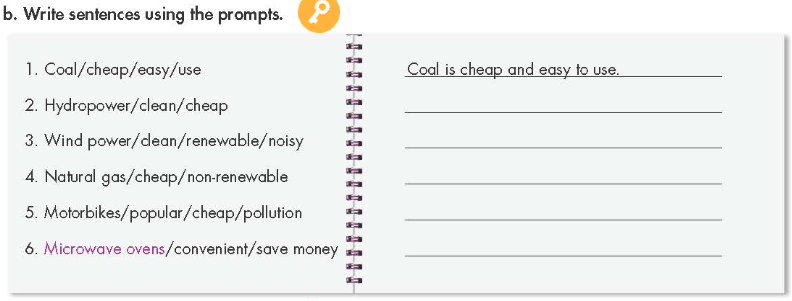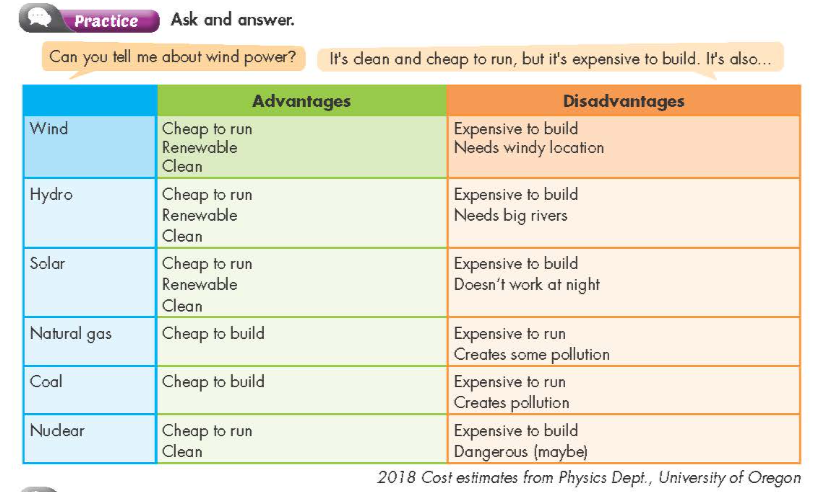Tiếng Anh 7 Smart World Unit 10 Lesson 2
Tiếng Anh 7 I-learn Smart World Unit 10 Lesson 2
Trong bài viết này, VnDoc giới thiệu tới các em Soạn Tiếng Anh 7 Smart World Unit 10 Lesson 2. Sau đây mời các em tham khảo chi tiết.
New Words
a. Match the words with the pictures.
(Nối từ với bức tranh tương ứng.)

Gợi ý đáp án
A. wind turbine
B. solar panel
C. power plant
D. nuclear power
b. Add each word/phrase (5–9) to the correct column. Listen and repeat.
(Thêm từng từ /cụm từ (5–9) vào đúng cột. Lắng nghe và lặp lại.)
Bài nghe

Gợi ý đáp án
|
Advantages |
Disadvangaes |
|
renewable |
non-renewable |
|
cheap to build |
expensive to build |
|
cheap to run |
expensive to run |
|
cheap to run |
cause pollution |
|
|
noisy |
|
|
dangerous |
c. In pairs: Discuss which energies you think are clean to run or cause pollution.
(Theo cặp: Thảo luận về năng lượng nào bạn nghĩ là sạch để tiến hành hoặc gây ô nhiễm.)
Gợi ý đáp án
I think wind power is clean to run.
I think natural gas causes pollution.
Reading
a. Read the text and underline the correct title.
(Đọc văn bản và gạch chân chủ đề đúng.)

Gợi ý đáp án
2. Comparing Different Energy Sources
Nội dung bài đọc
Lựa chọn tốt nhất cho năng lượng có thể khó khăn. Năng lượng từ than đá là dạng năng lượng phổ biến nhất hiện nay vì các nhà máy than không tốn kém để xây dựng. Các nguồn năng lượng không tái tạo khác như khí đốt tự nhiên, sạch hơn than đá, nhưng chúng vẫn không tốt cho môi trường. Các quốc gia hiện đang chuyển sang các nguồn năng lượng tái tạo như gió, mặt trời và thủy điện. Các nhà máy điện gió và năng lượng mặt trời sạch sẽ và rẻ để chạy, nhưng chúng không rẻ để xây dựng. Các nhà máy thủy điện cũng không gây ô nhiễm, nhưng chúng có thể tốn kém để xây dựng và ảnh hưởng đến môi trường bằng cách ngăn cá di chuyển tự do. Vì những lý do này, các quốc gia và thành phố thường chọn kết hợp các loại năng lượng.
b. Now, read and answer the questions.
(Bây giờ, đọc và trả lời câu hỏi.)

Gợi ý đáp án
1. They are common because they aren't expensive to build.
2. Because natural gas is cleaner than coal.
3. Wind power plants are clean and cheap to run.
4. Solar power doesn't work at night.
5. Hydroelectric plants stop fish from moving freely.
c. In pairs: Which of the energy sources is the best choice for the future of your country?
(Theo cặp: Nguồn năng lượng nào là lựa chọn tốt nhất đối với đất nước bạn trong tương lai?)
Gợi ý đáp án
A: Which of the energy sources is the best choice for the future of your country?
B: I think solar energy is the best choice for the future of my country.
Grammar
a. Listen and repeat.
(Nghe và lặp lại.)
Bài nghe

b. Write sentences using the prompts.
(Viết lại câu sử dụng gợi ý.)

Gợi ý đáp án
2. Hydropower is cheap and clean to use.
3. Wind power is clean and renewable, but it’s noisy.
4. Natural gas is cheap, but it’s non-renewable.
5. Motorbikes are popular and cheap, but cause pollution.
6. Microwave ovens are convenient and save money.
c. Fill in the blanks using “and or , but”.
(Điền vào chỗ trống sử dụng “and hoặc , but”.)

Gợi ý đáp án
|
1. but |
2. but |
3. and |
|
4. and |
5. and - but |
6. and - but |
Lời giải chi tiết
2. Nuclear power can sometimes be dangerous, but it's cheap to run.
(Năng lượng hạt nhân đôi khi có thể nguy hiểm, nhưng nó rẻ để vận hành.)
3. Microwave ovens are cheap and they use less electricity than electric ovens.
(Lò vi sóng rẻ và tốn ít điện hơn lò nướng điện.)
4. Solar panels save money and they are clean.
(Các tấm pin mặt trời tiết kiệm tiền và sạch sẽ.)
5. Coal power plants are popular and cheap, but they cause pollution.
(Nhà máy điện than phổ biến, rẻ nhưng gây ô nhiễm.)
6. My hometown is noisy and polluted, but I love living there.
(Quê hương tôi ồn ào và ô nhiễm, nhưng tôi thích sống ở đó.)
d. In pairs: Make sentences about different types of transportation. Use the prompts.
(Theo cặp: Viết câu về phương tiện khác nhau sử dụng gợi ý.)
Gợi ý đáp án
Airplanes are fast and convenient, but it’s pollution.
Cars are convenient, but it’s expensive.
Bicycles are clean, cheap and good for health.
Pronunciation
a. "...and..." often sounds like /n/.
("...and..." thường được phát âm giống /n/.)
b. Listen. Notice the sound changes of the underlined words.
(Nghe. Chú ý sự thay đổi âm thanh của những chữ được gạch chân.)
Bài nghe

c. Listen and cross out the sentence that doesn't follow the note in "a."
(Nghe và gạch bỏ câu không theo ghi chú ở phần a.)
Bài nghe

Gợi ý đáp án
Coal is cheap and eassy to use.
=> Sai vì không lược bỏ âm /d/ trong từ "and".
d. Read the sentences with the correct sound changes to a partner.
(Đọc câu đúng với sự thay đổi phát âm cùng bạn của em.)
Practice
Ask and answer.
(Hỏi và trả lời.)
Can you tell me about wind power?
It's clean and cheap to run, but it's expensive to build. It's also...

Gợi ý đáp án
A: Can you tell me about hydropower?
B: It's clean and cheap to run, but it's expensive to build. It's also need big rivers.
A: Can you tell me about solar power?
B: It's clean and cheap to run, but it's expensive to build. It doesn’t work at night.
A: Can you tell me about natural gas power?
B: It's cheap to build, but it's expensive to run. It also creates some pollution.
A: Can you tell me about coal power?
B: It's cheap to build, but it's expensive to run. It also creates pollution.
A: Can you tell me about nuclear power?
B: It's clean and cheap to run, but it's expensive to build. It also dangerous.
Speaking
a. In pairs: Discuss the advantages and disadvantages of the energy sources, and say why each would be good or bad for your city/town.
(Theo cặp: Thảo luận về lợi ích và bất lợi của nguồn năng lượng và nói tại sao mỗi nguồn năng lượng tốt hay xấu đối với thành phố/ thị trấn bạn.)

Gợi ý đáp án
Solar power is good for my city. Because it’s renewable, clean and cheap to run.
Coal is bad for my town. Because it’s nonrenewable, expensive to run and creates pollution.
b. Now, decide on the three best options, and what percentage each source should be.
(Bây giờ, quyết định trên 3 sự lựa chọn tốt nhất và mỗi nguồn năng lượng tương ứng với phần trăm bao nhiêu.)
Gợi ý đáp án
I think 10% of our energy should come from wind power.
I think 40% of our energy should come from hydropower.
Xem tiếp: Unit 10 Lesson 3 Energy Sources MỚI
VnDoc xin giới thiệu Soạn Tiếng Anh 7 i-learn Smart World theo từng Unit các hướng dẫn giải chi tiết cho từng phần trong SGK Tiếng Anh lớp 7 mới, kèm với đó là file nghe giúp các em hiểu bài học dễ dàng hơn.
Trên đây VnDoc đã giới thiệu tới các bạn Unit 10 Lesson 2 Energy Sources, hy vọng đây là tài liệu học tập hữu ích dành cho quý phụ huynh, thầy cô và các bạn học sinh.









